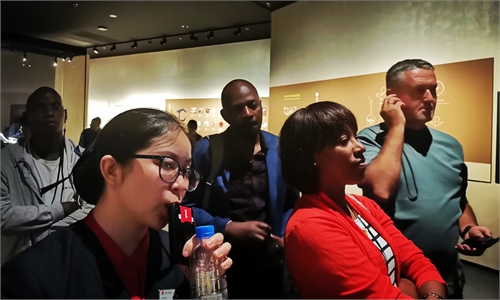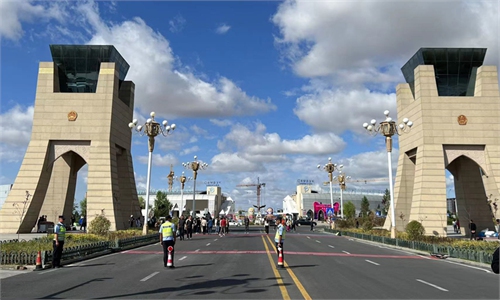ARTS / MUSIC
Concert highlights Silk Road spirit with creative, artistic presentation
Photo: Courtesy of China Shanghai International Arts Festival
A great round of applause burst out at the symphony hall when the last note ended. Images of a colorful and gorgeous world, built together by magnificent Western orchestral instruments and elegant traditional Chinese instruments echoed in the minds of the audience, who enjoyed a wonderful musical journey to the Silk Road.
As one of the highlights of the 22nd China Shanghai International Arts Festival (CSIAF) this year, the symphony concert Ode to the Silk Road, jointly presented by organizations including the Shanghai Symphony Orchestra and Shanghai Museum, was successfully performed on October 19 at Jaguar Shanghai Symphony Hall, receiving wide attention and praise.
This year marks the 10th anniversary of the Belt and Road Initiative (BRI). The concert was an artistic presentation of the impact of the ancient Silk Road and today’s BRI on human civilization, said Zhou Ping, head of the Shanghai Symphony Orchestra.
“The Silk Road is a shared stage to showcase the charm of different civilizations, as well as a common path for various civilizations to blend with each other and draw on their strengths,” Zhou told the Global Times on Tuesday.
Silk Road spirit
The concert consisted of three parts – “Quest” “Dream” and “Harmony” – based on three Silk Road-themed works by Chinese composers: Duo by Zhao Lin, Silk Road Reverie by Zhu Jian’er, and Ode to the Silk Road by Yu Ji, Zhou said.
Zhu composed Silk Road Reverie in the early 2000s and later adapted it into an orchestral version in 2008. It was his last work. Inspired by the ancient Silk Road, Zhu integrated five traditional Chinese instruments including the pipa (a time-honored string instrument), so the work is filled with typical Chinese elements.
Duo is a double concerto for cello and sheng, a Chinese free reed instrument consisting of vertical pipes. Its composer Zhao took inspiration from ancient 7th century Chinese Buddhist monk Xuanzang’s Great Records on the Western Regions, which recorded the experience of his trip to the West for Buddhist scriptures, as well as the local conditions in all the countries. The work had its world premiere in 2013, the first year of the BRI.
The third work Ode to the Silk Road was created by young composer and conductor Yu in 2022. It showcases the customs and traditions of the countries and regions along the Belt and Road with variations that draw on the folk music of the various regions along the route, reflecting the spirit of mingled cultures and integration.
It took years for the composers and the concert’s production team to create, adapt and polish the works, until it was eventually presented to the audience last week, Zhou said.
“Three generations of Chinese composers together contributed to the Silk Road-themed musical works,” she told the Global Times, noting that the concert showed the sincere feelings and diverse expressions of Chinese musicians about the spirit of the Silk Road: peace and cooperation, openness and inclusiveness, mutual learning and mutual benefit.
Creative cooperation
The concert was a creative cooperation with Shanghai Museum, which enriched the concert’s presentation with Silk Road-themed cultural relics collected by the museum.
On the night of the concert, several precious cultural relics from Shanghai Museum were exhibited at Jaguar Shanghai Symphony Hall. They showcase frequent trade and cultural exchanges among global countries and regions through the Silk Road on both land and sea.
The three parts of the concert correspond to the ancient land of the Silk Road, the ancient maritime Silk Road, and the current BRI, said Tang Shifen, secretary of the Party Committee of Shanghai Museum.
“Shanghai Museum experts chose representative cultural relics based on the three themes,” Tang told the Global Times.
She mentioned one of the exhibits, a painted foreign figure made in the Tang Dynasty (618-907). The figure has a typical appearance of a Persian male from the central and western Asian regions, which vividly demonstrates the prosperity of the Silk Road and foreigners’ integration into Tang Dynasty society.
Another exhibit was a blue and white dish with an image of a sailing boat, which came from the Kangxi period of the Qing Dynasty (1662-1722). The boat pattern on the dish shows similarities to the European sailboats at the end of the 17th century, reflecting the communications between the East and the West at that time.
“It is a representative cultural relic of the ancient maritime Silk Road,” Tang said.
The concert also required cooperation between various forms of artistic expression, said Tang, reflecting the efforts of BRI members in promoting people-to-people exchanges and communication among civilizations, she noted.



